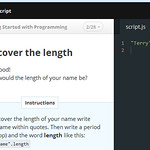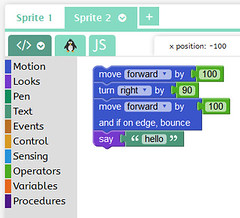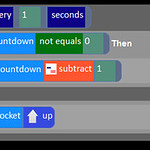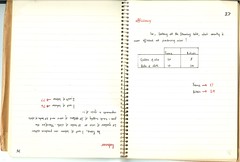Last night I attended the Owers Lecture on the subject of "Can we reverse the decline in schools' computing, especially with girls?" (I'll report on this in due course.) As the group called Computing at School was mentioned a lot, I thought I'd reproduce the following article from the April 2009 issue of Computers in Classrooms. The conference mentioned has, obviously, been and gone, but I think it's worth retaining that information for the links and because the agenda is interesting in itself.
The group has recently produced a glossy magazine (insofar as a pdf can be described as 'glossy'!) and some teaching materials, which I intend to review.
My own interest in this (as it's now de rigeur to declare one's interest, however slight) is that I love messing about with programming, having dabbled in Visual Basic and Visual Basic for Applications. Indeed, my chapter in the Year 8 book in the ICT 4 Life series is all about addressing the sequencing aspects of the National Curriculum through the use of VBA in a spreadsheet.
There is a looming crisis in the world of computing, says Roger Davies.
As the speed of technological developments increases and with it the need for ever greater  numbers of computer scientists, researchers and technologists the numbers opting to study computing in higher education have halved in the last ten years. There are many reasons; the image of the discipline, the lack of a coherent study pathway in secondary education, limited exposure to any computing before 16 to name just a few. Post 16 the numbers studying Computing are small. As a result, Computing teachers often feel isolated and face difficulties keeping up-to-date.
numbers of computer scientists, researchers and technologists the numbers opting to study computing in higher education have halved in the last ten years. There are many reasons; the image of the discipline, the lack of a coherent study pathway in secondary education, limited exposure to any computing before 16 to name just a few. Post 16 the numbers studying Computing are small. As a result, Computing teachers often feel isolated and face difficulties keeping up-to-date.
It is ironic that as ICT becomes increasingly ubiquitous, fewer children are being taught the fundamentals of computing, in particular programming. Bright students, of the kind who might make a career in computing, often progress in spite of, not because of, their school education.
Yet many children are curious about the technology we take for granted. They want to know how Google finds so many hits so quickly, and how it ranks them. How does an email get to its correct destination? How does file compression work? It is computing that gets i-tunes onto their mobiles, allows them to stream videos from across the world and buy things safely online.
In recent years, diverse groups of enthusiasts have sought to bring these concepts to life in a way that is understandable for children. For example Queen Mary College produce CS4Fn – a magazine aimed at secondary age pupils with a wonderful supporting website. Based at Glasgow University, Computer Science Inside have worked with teachers to develop a growing number of resources and in New Zealand the Computer Science Unplugged team have produced a marvellous collection of classroom activities to demonstrate computing concepts without the need for a computer.
If the thought of programming conjures up visions of blank faces staring at incomprehensible lines code it is time to rethink. There are many exciting resources that aim to introduce children to programming in enjoyable and engaging ways. GameMaker (developed at Utrecht University), Greenfoot, (Kent University), Scratch (MIT) and Alice from Carnegie Mellon are just some of the excellent free tools finding their way into schools.
The recent revision of the National Curriculum, with a new, welcome focus on sequencing provides an opportunity to replant the computing flag within our Key Stage 3 (11-14 years old) ICT provision. Computing has a rich and deep tradition and it is time for teachers to rediscover it. Programming teaches children the skills to dissect problems, understand the logic and sequences that lie behind solutions and be able to construct those solutions so a computer can execute them. These foundations provide generic and extendable skills that have value in many spheres beyond IT. As Nicolas Negroponte (architect of the OLC project) commented:
"Computer programming is a powerful tool for children to 'learn learning,' that is, to learn the skills of thinking and problem-solving... Children who engage in programming transfer that kind of learning to other things."
There is something special in pupils being able to get a computer to dance to their own tune. In my experience computing projects are highly motivational because of their capacity to make pupils think and stretch them. But above all else, they can be fun. One of my Year 9 (14-15 year old) pupils observed, on completing a unit using GameMaker:
“That was great. You normally teach the boring bits of my Mum’s job”.
‘Computing At School’ is an open, informal working group of enthusiasts that aims to promote Computing at school. Its membership is broad including teachers, examiners, parents, LEA advisors, university faculty, and employers. CAS was born out of our excitement with the discipline; a key goal being to put the fun back into teaching computing.
We would like to invite fellow teachers to an inaugural conference at Birmingham University on June 19th. Speakers will include Tim Bell (http://csunplugged.org/), Paul Curzon (http://www.cs4fn.org/), Michael Kölling (http://www.greenfoot.org) and Quintin Cutts (http://csi.dcs.gla.ac.uk/) amongst others. We hope this free event will provide an excellent opportunity to explore new ways to bring computing into our classrooms.
We hope the conference will provide a basis for creating an organization similar to the American Computer Science Teachers Association which has done much work to support teachers and promote a passion for computing. Please come and join us.
Further details about the conference and booking details can be found at http://computingatschool.org.uk/files/CAS_Conference_2009.pdf or by mailing conf2009@computingatschool.org.uk
Roger is Director of ICT, Queen Elizabeth School, Kirkby Lonsdale, Cumbria. He started the social network http://aqacomputing.ning.com/ which aims to provide a self help group for teachers involved in A Level Computing. He is a member of the CAS Working Group.
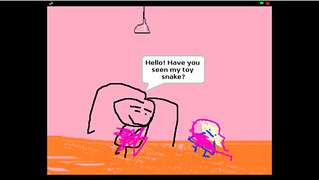 If you’re concerned that young children won’t be able to grasp computing concepts, or are worried about how you’re going to teach it, have a look around the Literacy from Scratch website.
If you’re concerned that young children won’t be able to grasp computing concepts, or are worried about how you’re going to teach it, have a look around the Literacy from Scratch website.

